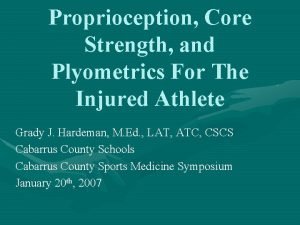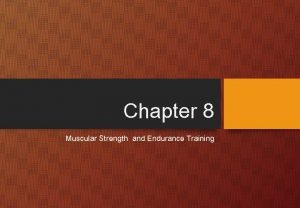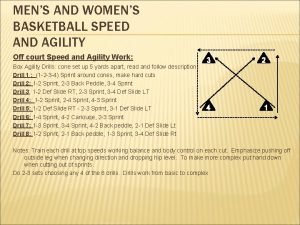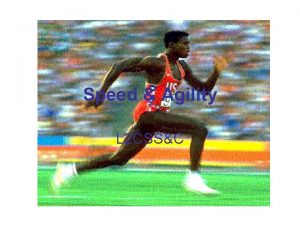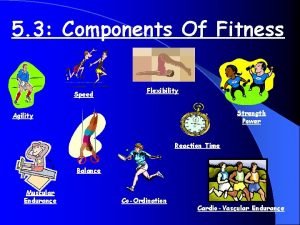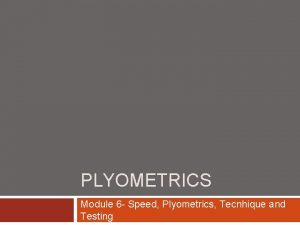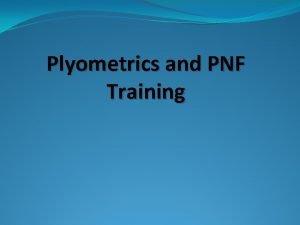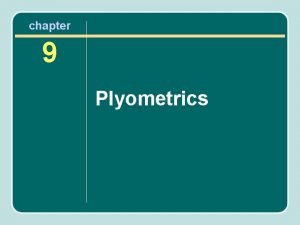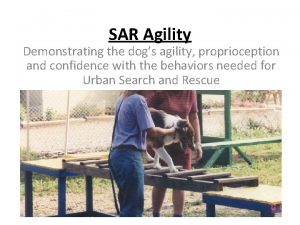SPEED AND AGILITY Module 6 Speed Plyometrics Technique











- Slides: 11

SPEED AND AGILITY Module 6 - Speed, Plyometrics, Technique and Testing

Speed, Agility, and Speed. Endurance Speed Agility The skills and abilities needed to explosively change movement velocities or modes Speed-endurance The skills and abilities needed to achieve high movement velocities The ability to maintain maximal movement velocities or repeatedly achieve maximal accelerations and velocities These abilities must be considered against the sport when designing a training program

Running Speed Running speed is the interaction of stride frequency and stride length Early Acceleration Due to increases in stride length Late Acceleration Due to increases in stride frequency

Figure 17. 3 Adapted, by permission, from Dillman, 1975.

Running Speed Stride frequency tends to vary among individuals and generally seems to be more trainable than stride length Sprinting Performance and Stride Analysis Linear sprinting involves a series of subtasks—the start and acceleration and maximum velocity. Though the movement mechanics of these subtasks are distinct, both are characterized by two phases: Flight Support

Figure 17. 5 Reprinted, by permission, from Schmolinsky, 2000.

Sprint Mechanics Figure 17. 7 - checklist for sprinting technique at start, acceleration, and maximum velocity Figure 17. 8 - fundamental movements of the flight and support phases in maximum velocity sprinting Table 17. 1 - sprinting technique errors, causes and concerns

Methods of Developing Speed and Agility Primary Method The primary method is the execution of sound movement technique in a specific task Initially, athletes should perform tasks at submaximal learning speeds to establish proper mechanics As they progress toward mastery, task performance can approach or exceed full competition speed

Methods of Developing Speed and Agility Secondary Methods Sprint This Resistance method includes gravity-resisted running (e. g. , upgrade or upstair sprinting) or other means of achieving an overload effect (e. g. , harness, parachute, sled, or weighted vest). The objective is to provide resistance without arresting the athlete’s movement mechanics, primarily as a means of improving explosive strength and stride length

Methods of Developing Speed and Agility Secondary Methods Sprint This Assistance method includes gravity-assisted running (e. g. , down-grade sprinting on a shallow [3 -7°] slope), highspeed towing (e. g. , harness and stretch cord), or other means of achieving an overspeed effect The objective is to provide assistance without significantly altering the athlete’s movement mechanics, primarily as a means of improving stride rate

Methods of Developing Speed and Agility Tertiary Methods Mobility Strength Inadequate ROM for a specific task can result in improper foot placement, longer ground times, and higher braking forces. Identify limitations due to flexibility, and address them in training. Prioritize strength training tasks by their dynamic correspondence with the target activity. SSC actions usually deserve high priority in speed and agility training. Speed-Endurance Repeatedly perform speed and agility tasks
 Agility hexagon agility test clockwise time
Agility hexagon agility test clockwise time Proprioceptive plyometrics
Proprioceptive plyometrics Plyometrics involves moving a weight as rapidly as possible
Plyometrics involves moving a weight as rapidly as possible Difference between strength and endurance
Difference between strength and endurance Depth jumps plyometrics
Depth jumps plyometrics Basketball 22's conditioning
Basketball 22's conditioning Fitness components
Fitness components Speed and agility frequency
Speed and agility frequency Component of speed
Component of speed C device module module 1
C device module module 1 How to find speed
How to find speed One effect of high speed driving is speed smear in which
One effect of high speed driving is speed smear in which

